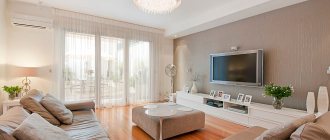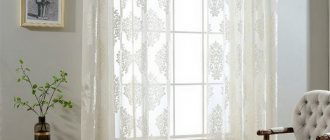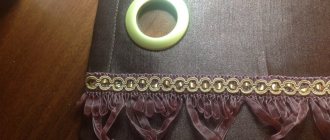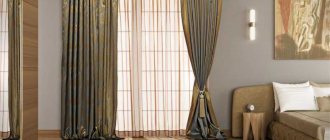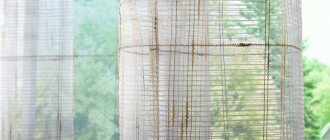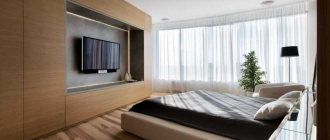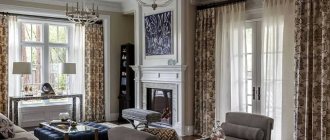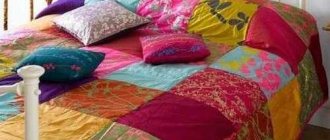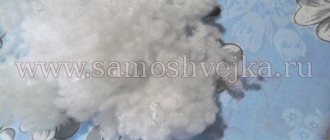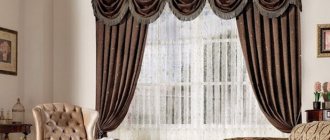The design of a window opening plays a vital role in interior design. Knowing how to choose tulle and curtains, you can transform the room, visually enlarge it, make it lighter and more comfortable. Correctly selected curtains can become an unusual accent in the design or complement an existing concept. Unfortunately, people often underestimate the importance of curtains, believing that they are not able to affect the overall appearance of the room. This statement is completely false. In this article we will get acquainted with various window design options, features of choosing curtains for each room, and also give examples of the most successful solutions with photos.
Choice
The choice of curtains must be approached responsibly. At first glance, it seems that the tulles are all similar, and it doesn’t really matter which one to choose. Photos of tulle in the interior, which can be seen on the Internet, do not convey all the features of the fabric and pattern.
In fact, all tulles are made of different quality, from different materials; their choice largely depends on the interior of the room and the taste preferences of the buyer.
Please pay attention to some nuances:
- For dark and colorful curtains, it is better to choose light tulle without patterns;
- A window with an adjacent balcony door can be decorated with asymmetrical tulle;
- Bright tulle will be an appropriate accent in a room where there are many elements of brown, gray or beige.
An interior without tulle looks empty and flat. Don't neglect this element of room decoration.
Kitchen
This room is characterized by a specific microclimate, so the requirements for the material from which the curtains are made are high. The fabric must be resistant to moisture, not absorb odors, and have dirt-repellent properties. Give preference to curtains that have been treated with special compounds that prevent them from fading and ignition.
Attention! As for the views, an excellent solution would be to install Roman or roller blinds. They do not require special care, are easy to clean, and do not take up much space.
They are a complete canvas, neatly assembled at the top of the window opening. This way they won't disturb you while cooking. In addition, a wide range of colors and textures will allow you to purchase the right product for any style. See for yourself by looking at photos of tulle for the kitchen in the interior and photos of new products that are relevant in 2021.
The main principle in kitchen design is simplicity and functionality.
Materials
Most often, tulle is sewn from light, thin fabrics that allow air and color to pass through. It can be organza, mesh, muslin or veil.
Organza is a durable material that is made by twisting several threads. This canvas is not afraid of dust. Organza can be made from silk or synthetic fabrics.
Veil is a universal material that is soft and tender. It is less transparent. The veil is made from silk, cotton, polyester or wool.
Kisey is a light cotton fabric. It is transparent, has a perforated structure, consists of individual threads, and is a mesh. This fabric has to be washed more often, as dust particles accumulate in it, but it can be washed in a washing machine. The fabric allows sunlight and fresh air to pass through.
Weaving types
According to the type of weaving, they are distinguished:
Note!
Curtains for windows - TOP 120 photo and video examples. Styles and shapes of curtains, their differences. Advantages and disadvantages of window curtainsDIY curtains - instructions for sewing curtains with your own hands. Types of fabrics, colors and patterns for curtains. 120 photos + video reviews
Photos of curtains: design of curtains of different sizes and lengths. Color range, types of materials, patterns and curtain fastenings (photo + video)
Batiste is a soft and smooth fabric. It consists of thin fibers that are tightly twisted. Patterns are often embroidered on it.
Jacquard is a durable fabric with a relief created by weaving threads of different thicknesses. Chiffon does not deform and is not difficult to care for. This type of weaving looks advantageous on windows that face north. It is better to combine it with plain curtains.
Chiffon is a textured fabric that is usually decorated with additional elements - bows, ribbons or flowers.
Colors
White tulle in the interior never loses its popularity. This is due to the fact that the translucent fabric is white:
- It seems light and airy. There is a feeling that the room is “breathing” and becomes fresher. This tulle makes the room visually wider;
- Combines with fabrics of any colors, with designs and patterns, with any style;
- Does not delay light, but only slightly diffuses it, making the lighting softer;
- Universal in many ways.
In the 21st century, white tulle is not the only option. Modern designers have found a lot of interesting variations in window design using tulle of different colors.
Pastel-colored tulle is combined with bright curtains; bright tulle can become an independent decorative element that creates an accent on the window.
Note!
- Organza tulle: advantages and disadvantages of the material. Varieties of tulle and fastenings. Tips for sewing and installation (photo + video)
Tulle design - TOP 130 photos + video reviews of tulle designs. Features of choosing fabric, length, quantity and type of tulle
Gray tulle: nuances of using gray tulle in the interior. Suitable gray fabric materials. 150 photos + video examples
Cream, beige or sand tulle can easily fit into almost any interior. For those who like to bring the most daring ideas to life, tulle is made in golden and silver colors.
A children's room allows you to decorate the interior with peach, lavender, lemon or light green tulle.
Yellow tulle creates a win-win combination with blue and green curtains.
Things to consider
Before choosing tulle for the kitchen or living room, it is worth determining exactly what function they should perform, and the room itself for which they are selected also plays an important role. What should you determine for yourself before choosing this or that tulle? These points are:
- They use tulle as window decoration or they carry a certain functional load.
- Consider the size of the window, its shape, as well as the overall stylistic design of the interior.
- Practicality and ease of use, for example, on the sunny side, tulle will fade faster than on the side of the apartment where less light enters the window. Ease of washing and ironing should also not be discounted.
Video on the topic:
According to interior style - choose the best
What should you pay attention to when choosing tulle, choosing it for a specific interior? Once you have decided on the fabric for the tulle, you should take a closer look at your own interior, into which it is selected and will fit organically. If you understand the characteristics of each material, this will allow you to decorate the window correctly. If you want to see a lot of folds and overhangs, the use of lambrequins - tulle should have a smooth surface of its fabric. The choice in this case may fall on organza and pliable veil.
With regard to color design, it all depends on the general situation, however, there is a rule to match the tulle to the color of the walls. But modernity is such that many modern designers recommend choosing printed tulle, making a bright accent on the window. If you want tulle to please the eye for a long time, choose green and orange tones.
If you want to lay tulle with draperies, you should buy a piece of fabric based on the length of the cornice, multiplied by 3 for a dense fabric, and if the fabric is light and airy, you will have to buy 5 times more. Now let's move on to the interior itself.
- If the room is designed in a minimalist style, the tulle also requires simplicity and the absence of unnecessary pretentiousness. In this case, it is optimal to focus on the texture of the fabric itself.
- For a classic interior and a room designed in the Baroque style, stylists recommend focusing on the use of flounces and drapery. And it is organza or muslin, muslin that are ideal for window decoration.
- For a room designed in an ethnic style, in one direction or another, textiles play a leading role in the choice. But the shape should correspond to the general theme of the room.
- When the style of ancient and vibrant India prevails in the room, it is optimal to use curtains rich in textiles, with rich patterns and rich colors. But it is recommended to choose tulle with gold/silver thread and rhinestone decor.
- Japanese style - simplicity and conciseness prevail in it; accordingly, the window curtains themselves should be made of smooth and thin fabric, such as organza or muslin. Also in this interior you can use curtains made of thicker silk, sewn in the style of Roman canvases.
- Hot Africa – it exudes a unique flavor. In such a room, it is optimal to decorate the windows with stylized curtains, complementing them with fabric made from natural threads.
Lighting and windows
The illumination of the room is just as important a criterion when choosing tulle, as is the size of the window opening itself. If the windows face south or southwest, the room will be brightly lit, and the curtain will act as a kind of protective screen, dissipating excess light. For such windows, you can opt for bright tulles, or, as an option, use a non-standard combination, for example, sewing it from several multi-colored fabrics.
When the windows face north, less light penetrates into the room and therefore in this case the choice should fall on light colors of the canvas. You can use a light canvas as the main window decoration, or use a more unconventional solution - hang the curtains in place of the tulle, and put it in the foreground. So the window seems to go deeper.
If the window is small, you should not choose dark tulle colors or choose thick fabric that will make the window opening even smaller. It is better to give preference to light colors and airy, weightless fabrics that easily transmit light. It’s easier with large windows - you can decorate it with tulle of any color without restrictions, add folds and draperies, use lambrequins. The main thing is to combine them with the interior and decor of the room.
Properly selected window decor is the key to successful design of the entire room. If you take our advice into account, you will make the right choice of tulle, succinctly complementing and completing the entire design and interior of the room.
Colorful and plain curtains
Plain curtains are chosen by people who want to achieve laconicism and tranquility in the interior. Tulle of the same color cannot spoil the interior, unless it is chosen completely without taking into account the color scheme of the room.
Multi-colored curtains look more original, but you need to choose them more carefully. The interior should be thoughtful and harmonious.
Note!
Tulle on a ribbon: advantages and disadvantages of tulle on a ribbon. Types of curtain tapes. Tips for sewing and installation (photo + video)Small curtains: TOP-180 photos + video of design options for small curtains. Features of small curtains in the interior. Types of curtains, fabrics and colors
Curtains for the hall: requirements for choosing curtains for the hall. Selecting the length, material and shade of fabric for curtains in the living room (photo + video)
Striped tulle in the interior looks appropriate if white vertical stripes are combined with pastel stripes of the same color. Sometimes bright, crazy solutions actually add color and style to the interior.
Patterns and designs on tulle should be repeated on other items. Then the room will resemble a fairy tale kingdom in which everything fits perfectly. Such a perfectionist's paradise can be created if you repeat the same pattern on decorative elements - on boxes and boxes, on a shelf, on a tablecloth or on a sofa.
The combination of several curtains in pastel shades looks very beautiful and elegant.
Children's
Bright curtains in a children's room develop the child's imagination
When choosing curtains for your baby’s room, you should be guided by his age, temperament, gender and preferences. A nursery is a special place where a child spends most of his time, so special attention should be paid to its arrangement.
Elegant translucent curtains are suitable for a young lady's room.
Important! Any material can be used to make curtains, but it is better to give preference to natural fabrics, as they do not cause allergies.
Satin curtains with guipure inserts - elegant and respectable
Don't forget that children love active games and often use decorative elements in them. The design of curtains should not contain sharp parts or small parts that can be swallowed.
Chintz curtains with small floral patterns will create a good mood for your baby
The color scheme and design must be selected in accordance with the overall style of the room. The child’s temperament also plays an important role: for choleric and sanguine people it is recommended to choose curtains in calm shades, while phlegmatic and melancholic people are better off with bright curtains. Use original tie-backs or magnets as decorations. Tulle in a boy’s nursery can be complemented with a colorful lambrequin with images of cars or airplanes.
Soft pink shades are a win-win option for decorating a little princess’s room.
Room size
The more ruffles, lace, embroidery and other details that give volume to the tulle, the more spacious the room in which it will be placed should be. In small rooms it is better to hang light, plain fabrics.
Above the windows located on the south side, you can hang tulle with a large pattern. A dark color will provide better protection from direct sunlight.
On the north side, white or light tulle made of transparent fabric will look ideal.
Which tulle is best to choose for rooms for various purposes?
When choosing tulle curtains, take into account the functional purpose of the room for which they are intended:
- For bedrooms, living rooms, and halls, long floor-length curtains are most often chosen. In the bedroom, thick muslin is used for single-layer curtains. You can choose a delicate translucent material, and provide light protection using roller blinds or Roman blinds with a thick fabric. In the hall or living room you need expensive, presentable curtains - a veil with lace inserts, organza, muslin, lace fabric, models with gold and silver patterns.
- In kitchens, short curtains are usually hung - up to the window sill. For this room, choose practical options that are easy to clean and can withstand frequent machine washing. Therefore, materials made from synthetic and mixed fibers are purchased for the kitchen. The colors are often bright, floral, checkered or striped.
- For a children's room in which a small child lives, short models are usually chosen so that the baby cannot tear the curtains or get entangled in them. The colors are bright, but not annoying. Drawing – floral, geometric, childish.
Before choosing tulle for window decoration, evaluate the size and architectural features of the room, interior design, intensity of lighting on sunny days, color of furniture and other textiles. Correctly chosen tulle curtains will refresh and decorate the room, correct the shortcomings of the room, and create a cozy and pleasant atmosphere.
Curtains for the living room
Tulle in the living room interior can be an accent or background. A plain, lightweight, pastel-colored fabric will decorate any living room, regardless of the style of the room.
The combination of bright curtains and delicate tulle creates comfort and harmony in the room. If you want to make the room more peaceful and relaxing, you need to choose tulle and curtains of the same color, but of different saturations.
Care Tips
Tulle, like any other fabric, needs special care. First of all, it is necessary to take into account the material of manufacture. If you buy a finished product, always pay attention to the manufacturer's advice. Let us describe several rules that are suitable for caring for standard tulle:
- If a stain has formed on the surface, it must be removed before washing, depending on the type of fabric;
- It is better to first shake the product and soak it briefly in a soap solution or with the addition of a powder suitable for the type of fabric;
- Hand washing is recommended, but since the volume of the product may be too large, machine washing on a delicate cycle is possible;
- The washing temperature should not exceed 40 degrees;
- To wash tulle, it is preferable to use liquid detergents, and when rinsing, add conditioner;
- When hand washing, do not twist the items. and when using a machine, set the spin speed to low;
- After washing, it is best to hang the curtains back in a slightly damp state. This will save time on ironing;
- If ironing of the product is necessary and permitted, it is best to carry it out through cotton cloth (or gauze) at a minimum temperature;
- It is not recommended to dry tulle in direct sunlight. This may cause the base color of the product to yellow or fade.
Choosing tulle for the living room is a responsible task. To choose the right one, you need to take into account a large number of factors. However, the result is an ideal place to relax and meet guests. Curtains will certainly add comfort and special charm to any room!
© 2021 textiletrend.ru
Curtains for the bedroom
In the bedroom, plain and delicate tulle creates an atmosphere of peace and comfort. The use of bright tulle is not allowed. It will irritate the eye and interfere with proper rest.
Tulle with guipure inserts is a combination of modern design and classics.
When choosing curtains for the bedroom, try to combine the colors of the tulle, curtains and bedspreads.
Fashion trends for curtains in the living room 2021
For the design of curtains for the living room in a modern style, simple shapes and neutral muted tones are now popular: milk, sea green, pine, shades of gray and brown. They do not tire the perception and fit into most interior styles.
Some styles (primarily classic) require decorating the room for receiving guests in richer and richer colors, so the curtains in the hall in such cases are often chosen in chocolate, malachite or purple. But even in such tones, the forms are usually simple, not overloaded with drapery and other decorations.
Modern curtains for the hall in pastel colors, such as lilac and powder, are also common.
Nowadays, curtains to match the wall decoration are popular. Finding a complete match can be difficult, especially if the walls are not monochromatic, but such a choice always attracts attention.
In general, designers more often choose plain textiles for the living room, but this year, options with ornaments, for example, silhouettes of tropical birds or various plant prints, are also becoming popular.
